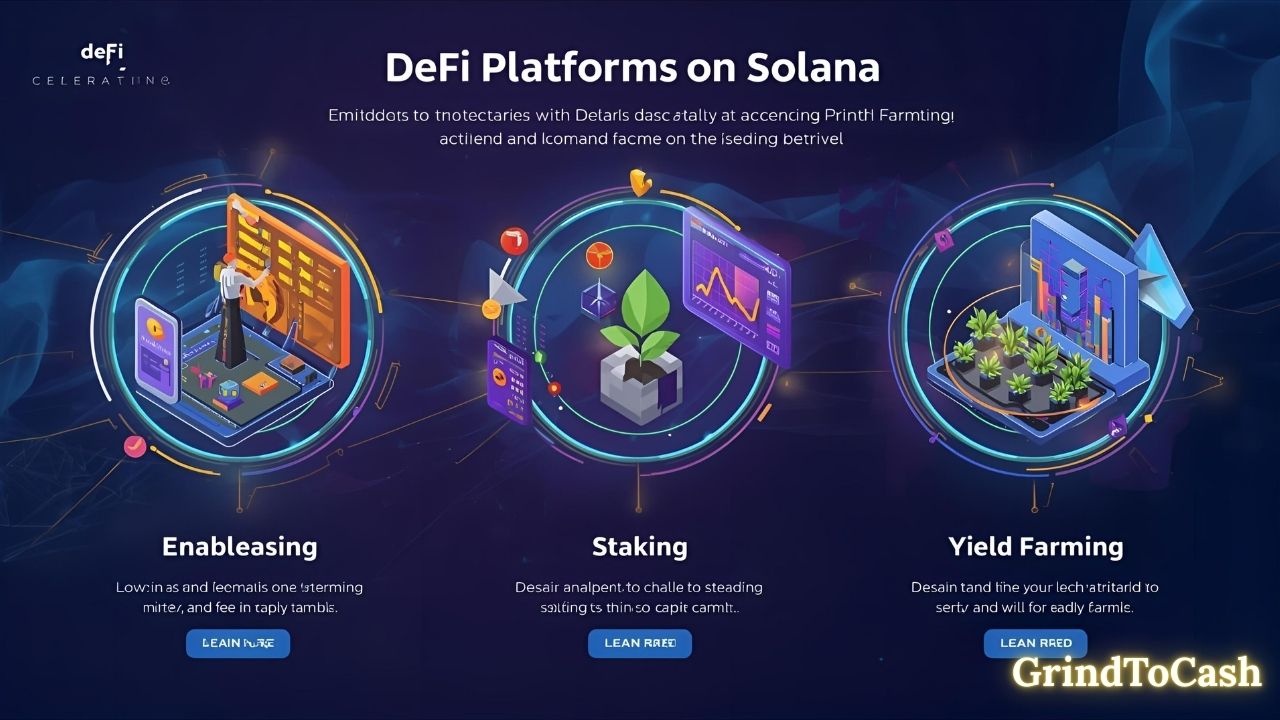Solana’s Breakthrough Journey: Fast Technology, Massive Adoption
Explore Solana’s breakthrough journey with lightning-fast technology and massive adoption, driving the future of blockchain, crypto, and Web3 innovation.
By Yaser | Published on September 16, 2025

Origins of Solana and Its Vision
Solana was created in 2017 with a bold mission: to deliver a blockchain that could solve scalability issues without sacrificing speed or affordability. While Bitcoin proved the potential of decentralized money and Ethereum showed the power of smart contracts, both struggled with transaction speed and fees. Solana entered the market as a new alternative, blending innovation and global ambition to support developers, investors, and mainstream adoption. This vision has since transformed Solana into one of the most talked-about projects in the Web3 world.
Founders and Early Team
Solana was founded by Anatoly Yakovenko, a former Qualcomm engineer who envisioned a blockchain that could process transactions as quickly as internet data flows. His background in distributed systems and telecommunications became the foundation of Solana’s architecture. Along with Raj Gokal and a team of skilled engineers, Solana Labs combined technical expertise with entrepreneurial drive to launch a blockchain designed for global use.
The Launch of Solana Labs
In 2018, Solana Labs officially launched with the aim of solving blockchain inefficiencies. The team secured initial funding through private sales and venture capital, fueling development. Their relentless focus on scalability and user experience allowed Solana to stand out in a crowded market. These early milestones built momentum and attracted attention from developers seeking a faster alternative to Ethereum.
Initial Goals and Market Position
From the beginning, Solana positioned itself as a blockchain for real adoption—fast, cost-efficient, and ready for developers. Competing against Ethereum and Bitcoin was ambitious, but Solana’s approach resonated with projects seeking scalability. Its vision of serving DeFi, NFTs, and Web3 apps gave it a clear market edge and positioned it as a serious contender among top blockchains.

Innovative Technology Behind Solana
At the core of Solana’s success is its groundbreaking technology. Unlike many blockchains that compromise between decentralization, security, and speed, Solana introduced a unique mechanism called Proof of History (PoH). Combined with Proof of Stake (PoS), this innovation enabled the blockchain to process thousands of transactions per second at a fraction of the cost. Solana’s architecture makes it attractive for developers building DeFi platforms, NFT marketplaces, and gaming applications.
Proof of History Explained
Proof of History is Solana’s defining feature, acting as a cryptographic clock that orders transactions before they enter the blockchain. This innovation drastically reduces the time needed for nodes to communicate and verify data. Instead of waiting for block confirmations, transactions flow seamlessly, allowing the network to achieve near-instant finality. This advancement gave Solana a reputation as one of the fastest blockchains.
Transaction Speed and Fees
Solana is capable of processing more than 65,000 transactions per second with fees as low as a fraction of a cent. This makes it highly competitive compared to Ethereum, where congestion often leads to high gas fees. The affordability and speed of Solana have encouraged widespread adoption, particularly among developers looking for efficiency. For everyday users, this means cheaper transfers, smoother app interactions, and greater accessibility.
Smart Contract Capabilities
Smart contracts on Solana are powered by Rust and C-based programming, giving developers flexibility and performance. By supporting high-performance applications, Solana has opened the door for advanced DeFi solutions and scalable NFT marketplaces. Its developer-friendly environment ensures that innovation continues to thrive, further strengthening its ecosystem.

The Rise of Solana in the Market
Solana’s growth has been nothing short of remarkable. Within a few years, it went from a new blockchain project to one of the top cryptocurrencies by market cap. Its fast adoption in 2020 and 2021 was fueled by DeFi, NFTs, and strong community engagement. This rapid climb demonstrated that the market was hungry for a blockchain that solved the speed and cost problems plaguing its competitors.
Major Price Breakthroughs
In 2021, Solana’s price surged from under $5 to over $200, cementing its place in the crypto spotlight. This incredible growth was driven by both speculative interest and real-world adoption. Investors saw Solana as a faster alternative to Ethereum, while projects found its low fees appealing. This price rally highlighted the project’s strong fundamentals and potential for long-term value.
Community Growth and Support
A thriving community became one of Solana’s strongest assets. Developers, investors, and users rallied behind the project, organizing events, hackathons, and educational content. The “Solana Summer” of 2021 became symbolic of its explosive growth. The community’s commitment to spreading awareness and supporting ecosystem projects played a crucial role in sustaining momentum.
Institutional Attention
As Solana gained popularity, institutional investors also started paying attention. Venture capital firms and major funds began investing in the ecosystem, giving it both credibility and financial backing. This helped accelerate project development and encouraged more businesses to build on Solana, further fueling its market expansion.

Solana and the DeFi Revolution
Solana quickly became a powerhouse for decentralized finance (DeFi). Its fast transaction speed and low fees provided an ideal environment for DeFi applications, which require efficiency and reliability. As Ethereum faced scaling issues, many developers shifted focus to Solana, driving rapid ecosystem growth.
Leading DeFi Protocols
Projects like Serum, Raydium, and Mango Markets thrived on Solana, offering decentralized trading, lending, and yield farming. These protocols showcased Solana’s ability to handle high-volume transactions without slowing down. By enabling innovative financial services, Solana positioned itself as a strong competitor in the DeFi space.
Liquidity and Yield Opportunities
Liquidity providers found Solana’s DeFi platforms attractive due to low fees and fast settlement times. Yield farming and staking opportunities became highly rewarding, drawing investors looking for passive income. This consistent activity boosted Solana’s total value locked (TVL), strengthening its role in decentralized finance.
Challenges and Competition
Despite its success, Solana faced competition from Ethereum and newer blockchains like Avalanche and Polygon. Outages and technical glitches occasionally raised concerns. However, Solana’s team worked on upgrades to improve stability, signaling their commitment to long-term growth. The ongoing competition only pushed Solana to evolve faster.

NFTs and the Creator Economy on Solana
NFTs played a major role in boosting Solana’s popularity. Thanks to low fees and high speed, Solana became a favorite blockchain for artists, collectors, and gaming platforms. Its NFT boom rivaled Ethereum’s, introducing millions of users to the ecosystem.
Solana NFT Marketplaces
Marketplaces like Magic Eden and Solanart became hubs for NFT trading. These platforms offered creators an affordable way to mint and sell digital art, while collectors enjoyed fast and inexpensive transactions. The NFT ecosystem brought cultural relevance and massive user growth to Solana.
Gaming and Metaverse Projects
Solana also attracted gaming developers building play-to-earn and metaverse projects. Its scalability allowed games to support thousands of users in real time. Projects like Star Atlas and Aurory highlighted how Solana could power immersive digital experiences, further expanding its ecosystem.
Cultural Impact of Solana NFTs
The rise of Solana NFTs created a vibrant cultural movement. From digital art to virtual communities, Solana became a symbol of creativity and accessibility. Its NFT scene helped onboard users who had never interacted with crypto before, bridging the gap between blockchain technology and mainstream culture.

Adoption and Real-World Use Cases
Beyond DeFi and NFTs, Solana is making strides in real-world adoption. From payments to tokenized assets, its ecosystem is expanding into industries like finance, gaming, and supply chain. This diversification ensures that Solana remains relevant beyond short-term hype cycles.
Partnerships with Businesses
Several businesses and startups have integrated Solana for payments and blockchain solutions. Partnerships with fintech companies and projects in emerging markets highlight Solana’s practical use cases. These collaborations strengthen its ecosystem and expand its global reach.
Integration with Web3 Ecosystem
Solana seamlessly integrates with wallets, exchanges, and cross-chain solutions, ensuring accessibility for users. Its interoperability with Ethereum through bridges enhances flexibility for developers and investors alike. This integration cements Solana’s role as a core player in the Web3 movement.
Use Cases in Emerging Economies
In countries facing inflation and limited banking access, Solana offers a cost-effective way to transfer and store value. Its affordability and accessibility make it an attractive option for people seeking financial inclusion. This real-world relevance supports Solana’s mission of global adoption.

Challenges and Controversies
No blockchain journey is without obstacles, and Solana has faced its fair share. While its technology is impressive, network outages, centralization concerns, and regulatory uncertainty have raised questions about its sustainability. These challenges represent important growing pains for a rapidly expanding ecosystem.
Network Outages
Solana has experienced multiple network outages caused by high transaction loads or technical bugs. While the team worked quickly to resolve issues, these incidents affected confidence in the blockchain’s reliability. Ongoing upgrades aim to improve resilience and prevent future disruptions.
Decentralization Concerns
Critics argue that Solana’s validator network is less decentralized compared to Bitcoin or Ethereum. Running a Solana node requires significant hardware, which raises barriers to entry. The team is addressing these concerns by incentivizing more validators and working toward better decentralization.
Regulatory Pressure
Like many cryptocurrencies, Solana faces scrutiny from regulators worldwide. Questions around securities laws, compliance, and investor protection add uncertainty. However, the project’s global presence and partnerships suggest it is working proactively to navigate these challenges.

The Future of Solana
Looking ahead, Solana’s future is filled with opportunities and challenges. As adoption grows and technology improves, its position in the blockchain ecosystem seems promising. Continuous innovation and strategic partnerships will be key to sustaining momentum.
Upcoming Technological Upgrades
The Solana team is working on upgrades to enhance scalability, reliability, and security. Features like better validator incentives and new developer tools aim to strengthen the network. These advancements will help ensure Solana remains competitive.
Expanding Ecosystem
Solana’s ecosystem continues to grow, with more projects, developers, and communities joining daily. From DeFi to gaming, NFTs to enterprise use cases, the variety of applications demonstrates its versatility. This expansion keeps Solana at the forefront of blockchain adoption.
Long-Term Outlook
While risks remain, Solana’s combination of speed, affordability, and community support gives it a strong long-term outlook. If it successfully navigates technical and regulatory hurdles, it could remain one of the leading blockchains shaping the future of Web3.
Conclusion: Solana’s Lasting Impact
Solana’s journey reflects the challenges and triumphs of blockchain innovation. From its origins to its adoption in DeFi, NFTs, and real-world use cases, Solana has proven its relevance. While it still faces obstacles, its technology and vision continue to attract global attention. At GrindToCash, we highlight Solana not just as a cryptocurrency but as a case study in resilience, growth, and the ongoing quest to revolutionize finance and technology.
As the blockchain industry evolves, Solana’s role will depend on its ability to maintain speed, affordability, and reliability. For users and developers alike, it represents both opportunity and innovation. Whether for investing, building, or learning, Solana remains one of the most influential projects shaping the Web3 era.









